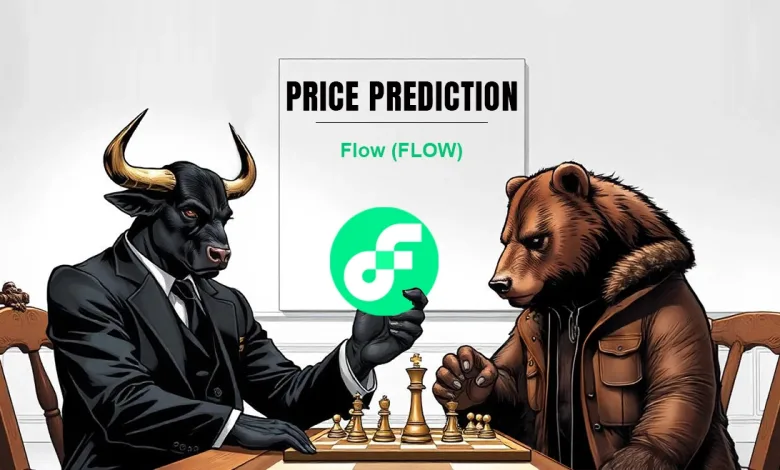Flow Price Prediction 2025-2035: Will It Hit $200 by 2035?

- FLOW’s positive OI-weighted funding rate signals strong long-term market confidence.
- The MACD index for the FLOW token remains bullish but shows weakening buying momentum.
- Bullish Flow (FLOW) price prediction for 2025 is anticipated to range within 0$0.10 to $25.
Flow (FLOW) Overview
| Cryptocurrency | Flow |
| Ticker | FLOW |
| Current Price | $0.3640 |
| Price Change (30D) | +0.24% |
| Price Change (1Y) | -59.58% |
| Market Cap | $575.02 Million |
| Circulating Supply | 1.57 Billion |
| All-Time High | $46.16 |
| All-Time Low | $0.3032 |
| Total Supply | 1.57 Billion |
What is Flow (FLOW)?
Flow is a blockchain platform created by Dapper Labs, the company behind the wildly successful CryptoKitties game. Flow was designed to address the limitations faced by Ethereum in handling popular decentralized applications (dapps), such as CryptoKitties, which suffered from network congestion and high transaction fees.
With Flow, the goal was to create a scalable and efficient blockchain platform optimized for blockchain-based games and digital collectibles. Flow’s native cryptocurrency, FLOW, fuels its ecosystem, facilitating transactions, staking, and governance.
How Did Flow Come Into Creation?
Dapper Labs, formerly Axiom Zen, had already made a name with CryptoKitties, a game that allowed users to collect, buy, and trade digital cats. However, the success of CryptoKitties exposed some of the scalability issues on the Ethereum network, which led Dapper Labs to look for a solution, resulting in the creation of Flow. Flow was explicitly designed to support the unique requirements of blockchain-based games and NFTs (non-fungible tokens), paving the way for the next generation of decentralized applications.
How Does Flow Work?
Flow operates on a unique architecture that divides its validation processes across four different types of nodes, making it more scalable and efficient than traditional blockchains:
- Collection Nodes: These enhance network connectivity and data availability for decentralized applications.
- Consensus Nodes: These decide the presence and order of transactions, ensuring consistency across the blockchain.
- Execution Nodes: These perform the computations required for each transaction, without any decision-making powers.
- Verification Nodes: These double-check the work done by the execution nodes, adding an additional layer of reliability.
This multi-node, multi-role architecture ensures that each node plays a specialized role in validating transactions, which helps Flow scale efficiently while maintaining the network’s security.
Developer Tools on Flow
Flow offers a suite of developer tools to make building decentralized applications easier. The platform uses Cadence, a programming language developed by Dapper Labs specifically for Flow. Cadence allows developers to create smart contracts for dapps, such as those used to create NFTs or decentralized marketplaces. Moreover, Flow’s beta release system enables developers to release their applications incrementally, making fixing bugs and addressing issues easier without affecting the final product.
The Technology Behind Flow
At its core, Flow employs a highly flexible and scalable architecture powered by Corda technology. Unlike traditional blockchains, which rely on a single chain, Corda enables Flow to run multiple parallel chains, each optimized for different use cases. This approach ensures that Flow can handle a wide range of decentralized applications without compromising performance or scalability. Additionally, Flow uses a Proof of Stake (PoS) consensus mechanism, where validators stake FLOW tokens to participate in the network and earn rewards.
FLOW Token: The Heart of the Flow Blockchain
The FLOW token is an essential part of the Flow ecosystem, with various functions and utilities:
- Transaction Fees: FLOW tokens are used to pay for transaction fees on the network.
- Staking: Validators stake FLOW tokens to help secure the network and participate in its governance.
- Governance: Although on-chain governance is not yet live, FLOW will eventually allow token holders to vote on key decisions affecting the network.
- Issuance and Rewards: The supply of FLOW is inflationary, with an annual issuance rate of around 3%. Newly issued FLOW tokens, along with transaction fees, are allocated as network rewards to the nodes that validate transactions.
The Full Structure of FLOW Token
At the time of Flow’s launch in 2020, there were 1.25 billion FLOW tokens. These tokens were distributed as follows:
- 32% for ecosystem development
- 20% for Dapper Labs, funding the development of the blockchain
- 18% for the development team
- 10% for community sales
- 20% for backers and investors
Flow’s tokenomics ensure the platform’s long-term growth and sustainability by rewarding validators, incentivizing ecosystem development, and funding the development team.
Flow Price History
FLOW made an explosive entrance into the crypto scene, launching at just $0.38 before catapulting to an all-time high of $46.16, an incredible 11,000% rally. However, the hype was short-lived, as FLOW hit fierce resistance near its peak, triggering a steep 86% correction down to around $6.01.
Not ready to throw in the towel, FLOW staged an impressive comeback. It rallied nearly 400%, soaring back up to $29.71. However, the token met heavy resistance again, this time, right at the critical 61.8% Fibonacci level, which halted its recovery.
Failing to break through, FLOW began another sharp descent, eventually settling into a prolonged consolidation phase between $3.22 and $0.30. Since mid-2022, FLOW has been stuck in this tight range, struggling to find the momentum needed for a breakout.
The token hovers dangerously close to its all-time low of around $0.30 at press time. Assuming the token’s bearish pressure continues in the long term, FLOW could break lower, pushing into new, uncharted territory.
Nevertheless, if buyers step in with strength, FLOW can break above its consolidation zone. A successful breakout could target the $25–$29 resistance area, and if momentum builds, perhaps even a push toward its former highs.
FLOW Bulls Stir as Positive Sentiment Builds
Adding to the optimism, Coinglass data shows that FLOW’s open interest (OI)-weighted funding rate has shifted into positive territory. As of press time, the funding rate sits comfortably in the green zone at 0.0090%, with long position holders paying a premium to short sellers to keep their trades open.
This behavior is a strong indicator of growing market confidence. Traders are showing a willingness to bet on FLOW’s upside potential, suggesting that many believe the token may soon break out of its prolonged consolidation phase.
While the price remains near historic lows around $0.30, the positive funding rate hints that sentiment could be slowly turning bullish. If this trend holds, it could provide the fuel needed for FLOW to mount a serious comeback, first targeting a break above the $0.30-$3.22 consolidation range and possibly setting sights on higher resistance levels.
Related: DEEP Price Prediction 2025-35: Will It Hit $15 by 2035?
Yearly Highs and Lows of Flow
| Year | Flow Price | |
| High | Low | |
| 2025 | $0.85006 | $0.3032 |
| 2024 | $0.69662 | $0.43937 |
| 2023 | $1.44687 | $0.39159 |
| 2022 | $9.45 | $0.64338 |
| 2021 | $46.16 | $0.38 |
Flow Technical Analysis
The MACD for FLOW on the monthly chart remains bullish, with the MACD line at -1.28 above the signal line at -1.75. However, the histogram bars are shrinking, indicating weakening bullish momentum. This suggests that while FLOW retains some upside potential, buying pressure is fading and could lead to a shift in trend if the slowdown continues.
Meanwhile, the RSI (Relative Strength Index) reading is 43.89, which is below the neutral 50 mark and is in bearish territory. If the selling pressure increases, it could continue to decline below the 40 mark.
Flow (FLOW) Price Forecast Based on Fair Value Gap
FLOW’s monthly chart highlights two prominent Fair Value Gaps (FVGs) that could act as critical resistance zones if the token attempts a recovery. The first FVG lies between approximately $4.30 and $2.70, while the second, larger FVG spans from around $11.30 to $9.45.
Historically, such gaps often attract price action when revisited, but they can also serve as strong barriers against upward movement. Given FLOW’s price, the rally must first challenge the lower FVG zone ($4.30–$2.70). This region represents a major hurdle in which selling pressure could intensify as previous liquidity imbalances are corrected.
If bulls manage to overcome this initial resistance, the next key target would be the higher FVG near $11.30–$9.45, where even stronger resistance is likely. Price action shows that FLOW has been consolidating below $1.00 since mid-2022, suggesting a significant lack of bullish momentum.
Reclaiming either FVG will require sustained buying pressure and volume. While the gaps present upside targets, they warn of potential rejections that could stall any bullish breakout attempts, reinforcing the need for caution in optimistic projections.
Flow (FLOW) Price Forecast Based on MA Ribbon Analysis
On the monthly chart, FLOW’s 20-period moving average (MA) sits at $0.69635, well below the 50-period MA at $4.95084. This gap between the two MAs signals a strong, long-term bearish trend, confirming the persistent downward pressure that has dominated FLOW’s price action since mid-2021.
Typically, when the 20 MA trades below the 50 MA, it reflects an established bearish market structure. In FLOW’s case, the steep divergence further emphasizes the token’s struggle to gain bullish momentum, especially considering the price remains significantly below both averages.
Additionally, the distance between the two MAs shows no signs of narrowing, indicating that any potential trend reversal could take considerable time to materialize. For FLOW to hint at a bullish recovery, the price would first need to close above the 20 MA at $0.69635, followed by sustained movement toward the 50 MA at $4.95084.
Flow (FLOW) Price Forecast Based on Fib Analysis
FLOW trades near the 0% Fibonacci retracement level at $0.30, highlighting its deep retracement from its all-time high. As the token remains extremely close to its lowest recorded Fib point, it indicates a prolonged bearish phase with minimal bullish recovery.
However, if FLOW initiates a bullish reversal, the first major resistance would emerge at the 23.6% Fib level near $10.36667. A successful break above this region could open the path toward the 38.2% Fib level at $16.59295. Beyond that, the 50% retracement at $21.62514 stands as a critical psychological and technical resistance zone, marking the halfway point of FLOW’s full decline.
Further bullish momentum could challenge the 61.8% level around $26.65733, a key area often associated with major trend reversals in Fibonacci analysis. The final strong Fib resistance sits near 78.6% at $33.82182, just before FLOW’s all-time high.
Flow (FLOW) Price Prediction 2025
According to CryptoTale’s projections, FLOW could surge between $0.10 and $25 by 2025, fueled by post-BTC halving hype. The bullish momentum is expected to push prices significantly higher before facing intense volatility and an eventual market-wide correction phase later in the year.
Flow (FLOW) Price Prediction 2026
As per CryptoTale’s forecast, FLOW may decline to between $10 and $20 in 2026, mirroring historical recession phases after euphoria peaks. Market depression, reduced liquidity, and negative sentiment could drive significant retracements across the crypto sector, severely impacting FLOW’s value.
Flow (FLOW) Price Prediction 2027
CryptoTale anticipates FLOW will stabilize in the $5–$15 range by 2027, with prices bottoming out during this extended bear cycle. Early signs of recovery could appear as market participants prepare for the next BTC halving in 2028.
Flow (FLOW) Price Prediction 2028
According to our price forecast, FLOW could rise to $25–$50 in 2028 as the market shifts into a bullish phase. Growing anticipation around Bitcoin’s 5th halving event and investor optimism would likely fuel a gradual market recovery.
Flow (FLOW) Price Prediction 2029
As per CryptoTale’s prediction, FLOW may reach between $40 and $80 in 2029, driven by post-halving rally expansion. Renewed institutional interest, innovation in blockchain gaming, and NFTs could catalyze FLOW’s growth alongside broader crypto market optimism and investor influx.
Flow (FLOW) Price Prediction 2030
According to our forecast, FLOW could correct down to $35–$60 by 2030, aligning with a market-wide overvaluation cooldown. After sharp post-halving expansions, historical trends suggest consolidation phases where inflated prices correct and recalibrate to realistic valuations.
Flow (FLOW) Price Prediction 2031
As markets stabilize, cryptoTale projects FLOW could trade between $30 and $50 in 2031. Confidence could gradually rebuild following the 2030 correction, with FLOW benefiting from improved regulations, blockchain advancements, and steady growth in dApp and NFT ecosystems.
Flow (FLOW) Price Prediction 2032
According to our forecast, FLOW could climb sharply to $50–$100 in 2032, riding the bullish hype of Bitcoin’s 6th halving event. Market excitement, increased adoption, and renewed enthusiasm could fuel significant upward movement across major altcoins like FLOW.
Flow (FLOW) Price Prediction 2033
CryptoTale predicts FLOW may rally between $95 and $150 in 2033 during the expansion phase. Post-halving momentum, technological progress in blockchain gaming, and growing mainstream adoption could push FLOW toward new heights, surpassing previous cycles’ resistance zones.
Flow (FLOW) Price Prediction 2034
According to CryptoTale’s projections, FLOW may dip to $80–$120 in 2034 amid overvaluation fears and profit-taking. Following historical patterns, late-cycle corrections typically emerge as investors cash out, leading to a healthy market reset before the next bullish drive.
Flow (FLOW) Price Prediction 2035
According to our forecast, FLOW could soar between $110 and $200 in 2035, fueled by widespread blockchain adoption, stable crypto regulations, and anticipation of the 2036 Bitcoin halving. FLOW may set new all-time highs amid renewed institutional and retail enthusiasm.
Related: The Graph Price Prediction 2025-35: Will It Hit $50 by 2035?
FAQs
FLOW is the native cryptocurrency of the Flow blockchain, designed by Dapper Labs to support scalable games, NFTs, and decentralized applications.
You can buy FLOW on major cryptocurrency exchanges like Binance, Coinbase, and KuCoin using fiat, Bitcoin (BTC), Ethereum (ETH), or stablecoins.
Investing in FLOW offers potential, especially during bullish cycles, but it carries high risk due to crypto market volatility. Always conduct thorough research.
The safest method is to use hardware wallets like Ledger or Trezor. Alternatively, use reputable non-custodial wallets that support FLOW.
FLOW was created by Dapper Labs, the same team behind CryptoKitties, with Roham Gharegozlou as CEO.
FLOW was officially launched in 2020 by Dapper Labs to address scalability issues facing blockchain-based games and dapps.
FLOW’s current circulating supply is approximately 1.57 billion tokens.
According to projections, FLOW could surpass its $46.16 all-time high, driven by adoption, market cycles, and blockchain advancements.
FLOW’s all-time low is around $0.3032, recorded after a prolonged bearish phase.
During the post-BTC halving market excitement, FLOW is forecasted to range between $0.10 and $25 in 2025.
In 2028, FLOW could trade between $25 and $50, fueled by bullish momentum because of Bitcoin’s 5th halving.
price
FLOW could rally between $50 and $100 in 2032, driven by Bitcoin halving hype and renewed crypto adoption.
FLOW could soar to between $110 and $200 in 2035, reaching new highs amid adoption, regulations, and anticipation of 2036 Bitcoin’s halving.





